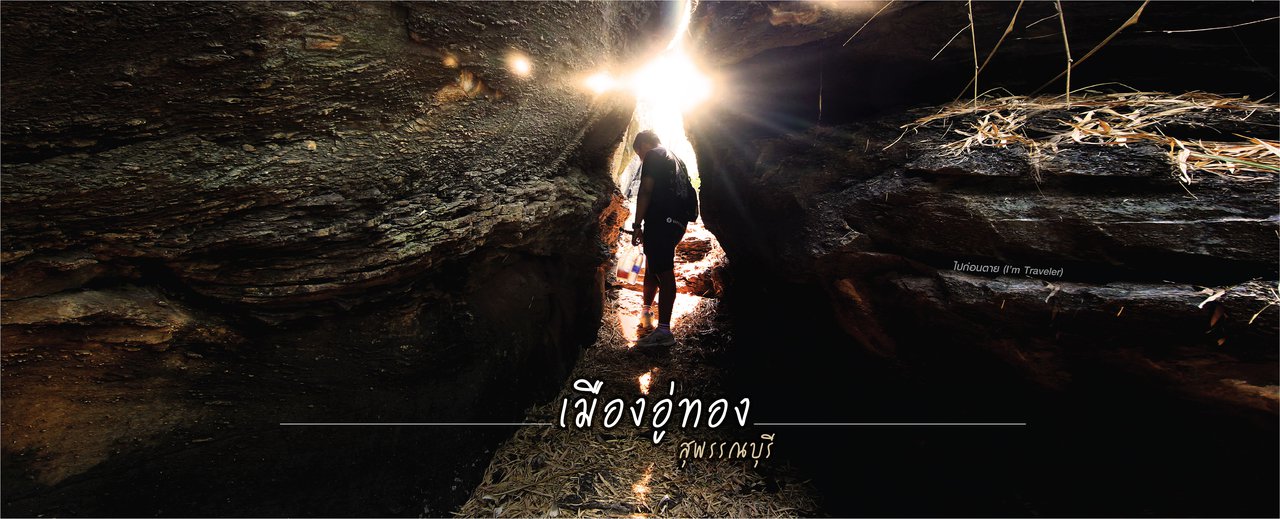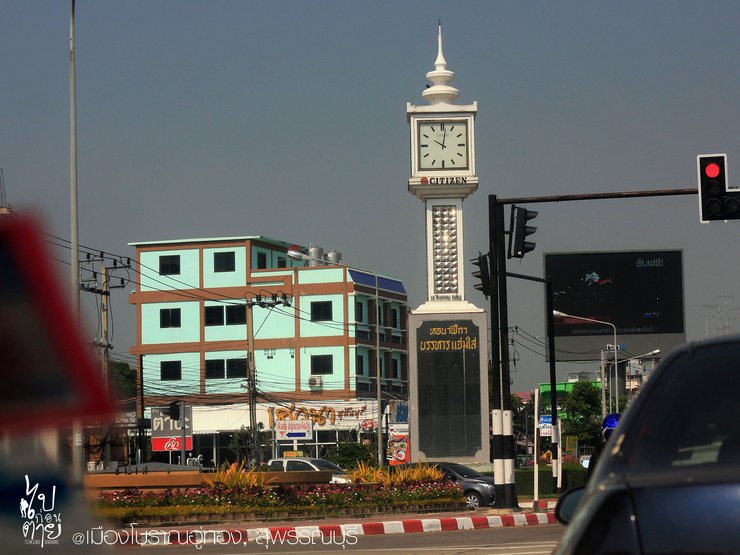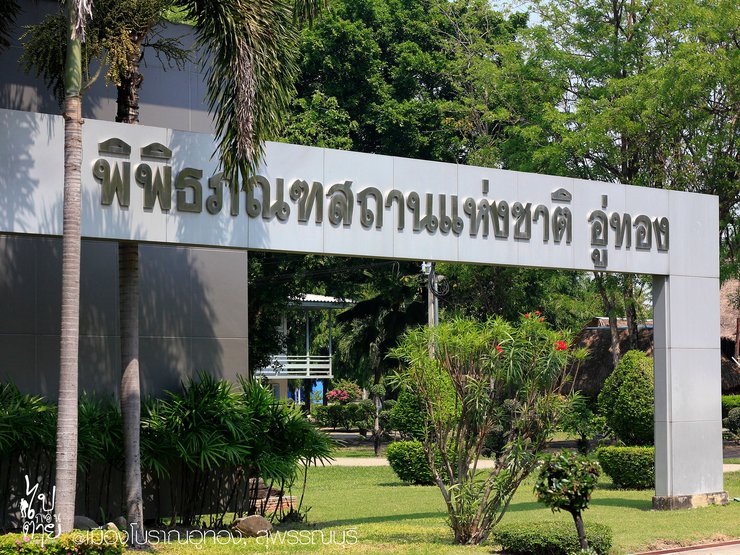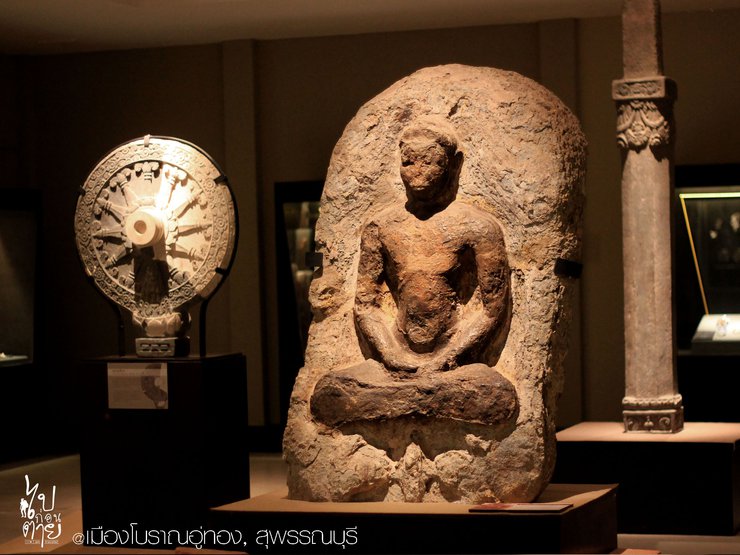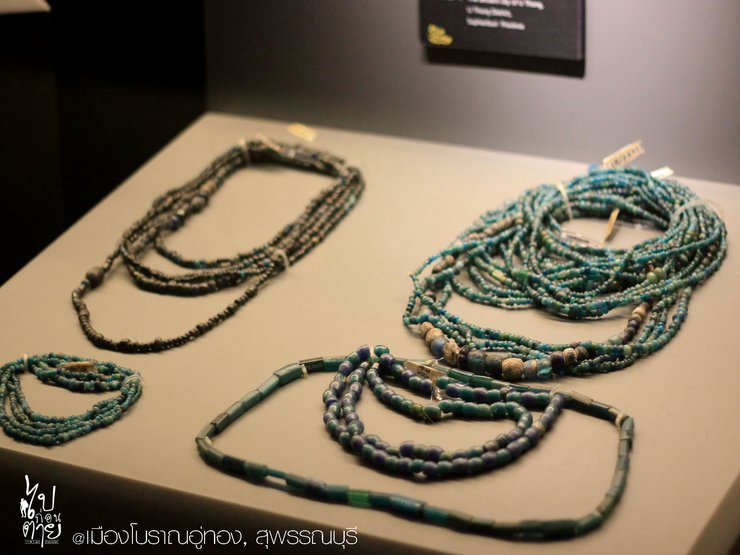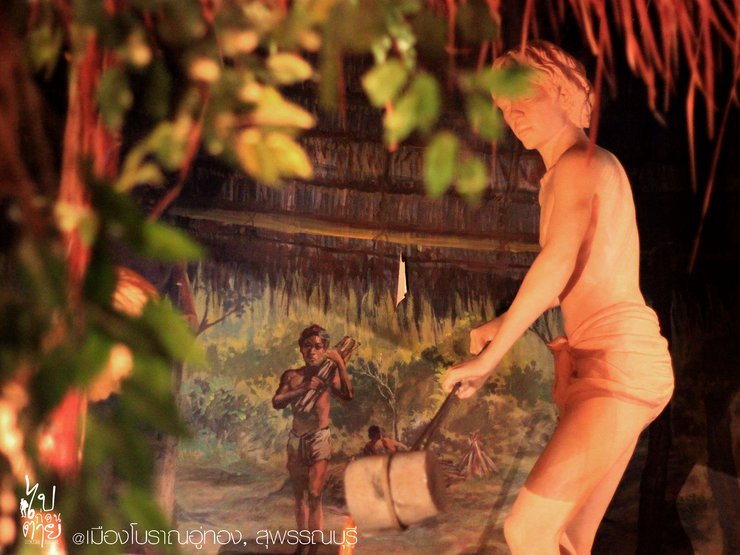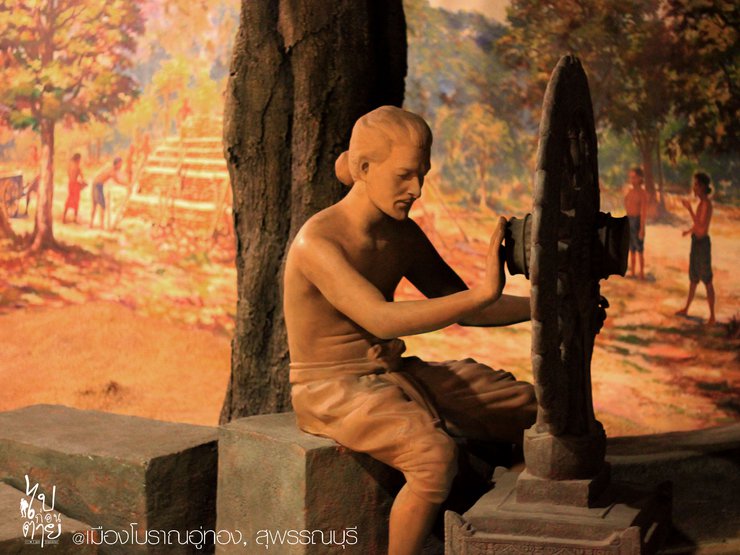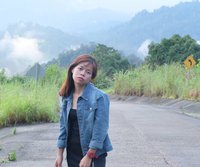Connect with me on Facebook Fan Page or Govivigo Blog
U Thong, Suphan Buri
"U Thong, the ancient city, the origin of history, the civilization of Suvarnabhumi"
Suphan Buri is another province that Pan travels to frequently because it is a province that is very close to Bangkok. It only takes 2 hours to drive there. It is also a small province with a lot to offer. For example, this time Pan returned to Suphan Buri again because of the "Ao Jao Kaew" trend. Haha, don't rush to frown and scratch your head, wondering why if you watch this drama, you should go to Ayutthaya, how can you end up in U Thong city?

Answer! ......
Many people have flocked to Ayutthaya, but I wanted to go back further in time, thousands of years back. This is the starting point of my trip. The two main places I will visit are the U Thong National Museum and the Phu Hin Rong Kla National Park. I will definitely visit these two places, but if I have time, I will visit other places as well. The ancient city of U Thong has many interesting places to visit, including temples with a long history, which are suitable for those who like temples and merit-making, as well as museums that I, as a gallery enthusiast, really enjoy. There are also various natural attractions and the people of Suphan Buri who make it easy to fall in love with this city.
Travel
Bus: I must say, I'm impressed. Unlike other provinces, Suphan Buri doesn't have motorbike rentals. While you can take a songthaew from the transportation hub to U Thong, it will take a very, very long time. Your best bet is to ask the songthaew drivers in the city center to rent a car to U Thong.
Private car: Open Google Maps and head to Suphan Buri. Type "U Thong" as your starting point, similar to Pan's suggestion. You can begin at the "U Thong National Museum" and then visit other tourist attractions. Refer to the following map for guidance.

Image from "Sustainable Tourism Information System (STIS)"
Enter the ancient city!!!
This sentence describes the abundance of clock towers in Suphan Buri, Thailand, suggesting it might be the province with the most in the country. The author humorously notes that this prevalence of timepieces makes the residents "people with a lot of time." The sentence also mentions that traffic in the ancient city of U Thong is not overly congested, with some delays only at traffic lights.

National Museum U Thong
The museum was established to preserve and exhibit archaeological and artistic artifacts unearthed in the ancient city of U Thong and surrounding areas. The abundance and clarity of prehistoric (1900 years ago) remains, including tools, utensils, and traces of human settlements, discovered in U Thong compared to other regions led to the designation of U Thong District, Suphan Buri Province, as the "Ancient City of U Thong," as Pan mentioned earlier.
On Friday, **May 13, 1966**, Their Majesties King Bhumibol Adulyadej and Queen Sirikit presided over the opening ceremony of the U Thong National Museum.

The museum is divided into two exhibition buildings connected by a staircase. Upon entering, visitors need not worry about which way to go first, as staff are available to guide them from the moment they purchase their tickets. The first room, as guided by the staff, is a video room that provides a brief overview of the history of U Thong. Visitors can watch the video until the end before proceeding to the next rooms.

Exhibition Halls
There are a total of 6 exhibition halls.
Hall 1: The Ancestors of U Thong
Exhibition on the development of the ancient city of U Thong, from prehistoric life to the Metal Age.
Exhibition Room 2: U Thong Sri Dvaravati
The exhibition tells the story of U Thong's past as a center of trade and Buddhism. The city's well-designed layout, with moats and earthen ramparts surrounding the inner city, facilitated trade, agriculture, and the spread of Buddhism.
Room 3: Historical Development on the Land of Suvarnabhumi
The Golden Land: Exploring the Historical Development of U Thong
This room showcases the historical development of the ancient city of U Thong, also known as "Suvarnabhumi," meaning "Land of Gold." Visitors will discover why this region was revered as a land of gold.
Room 4: Suvarnabhumi, a Global Trading Center in the Ancient Era
This room delves into the fascinating history of Suvarnabhumi as a major trading center in the ancient world.
The Maritime Trade Simulation Room
This room simulates the maritime trade that took place between the Indian subcontinent and the land of Suvarnabhumi over 3,000 years ago.
Exhibition Room 5: U Thong, Center of Buddhism
Room 5: The Dawn of Dvaravati Culture (1,600-1,800 years ago)
This room delves into the pivotal role of U Thong as a major early city influenced by Buddhism from India, approximately 1,600-1,800 years ago. This influence marked the genesis of the Dvaravati culture, evident in the artistic expressions of the period, which exhibit a blend of Indian artistic elements.
Room 6: Rotating Exhibitions
This final room is dedicated to rotating exhibitions, ensuring that the museum remains fresh and engaging. Visitors can expect to encounter new and exciting displays with each visit, as the exhibitions are regularly updated to reflect current events and interests.


The exhibition features both genuine and replica artifacts. Each room has dedicated staff members who are knowledgeable and eager to answer any questions you may have. Don't hesitate to approach them for clarification. However, please be aware that even though some artifacts are displayed openly without glass barriers, it is crucial to refrain from touching or tapping them to avoid causing damage. Remember, be a responsible visitor: observe with your eyes and seek information from the staff.











However, what made Pan extremely regretful was...
Pan missed the opportunity to visit the "Lao Song House," another exhibition building at the museum. She was unaware that it was open to the public and filled with interesting photo opportunities. Upon returning home and researching, she discovered that the museum extended beyond the main building.
Lao Song House
The traditional Thai house, known as "Rueaan Lao Song" or "Rueaan Thai Song Dam," is located near the exhibition hall. The interior replicates an ancient Thai house, complete with stucco decorations and replicas of everyday objects used by people during that era.

Image source: http://www.thainewsvision.com/%E0%B8%AD%E0%B8%9E%...
Contact Information
National Museum U Thong
Address: Malai Man Road, U Thong Subdistrict, U Thong District, Suphan Buri Province 72160, Thailand
Phone/Fax: 035-551021
Opening Hours:
Open Wednesday-Sunday and public holidays (closed Monday-Tuesday)
Opening Hours and Admission Fees
9:00 AM - 4:00 PM
Admission Fees:
Admission fee for Thai citizens: 30 baht
Foreigners 150 baht
Note: Exemptions from fees apply to students in uniform, monks, novices, and religious clergy of all faiths, and senior citizens over 60 years of age.
The World's Largest Carved Buddha Image
The Great Buddha of Thailand
According to the map provided by the Tourism Authority of Thailand (TAT), there is another point of interest located near the museum. This point of interest is the "Wat Khao Tham Thiam" temple, which is located a short distance from the museum on the same road. The temple is home to a massive art installation, which is expected to become a major landmark in the province of Suphan Buri once construction is completed.

Interesting Facts About the Giant Buddha Statue
1. A Majestic Figure: The Phra Buddha Pushyakiri Sri Suwannabhumi is a colossal Buddha statue carved into a cliff face, depicting the posture of pacifying the Buddha's mother. It stands majestically at the foot of the Mangkorn Bin Cliff at Wat Khao Tham Thiam.
2. Monumental Dimensions: This awe-inspiring statue boasts a height of 108 meters, a base width of 88 meters, and a lap width of 65 meters.
3. Part of a Grander Vision: The construction of the Phra Buddha Pushyakiri Sri Suwannabhumi is part of a larger project to create a Buddhist park in the Suphan Buri province, encompassing the surrounding area.
4. Expansive Construction: The project spans an impressive 100 rai of land.
5. Unveiling the Mystery: While the exact completion date remains unknown, visitors can still marvel at the statue and participate in merit-making activities at the entrance.
6. A Costly Endeavor: The construction budget remains undisclosed, but its sheer scale hints at a staggering sum.



The image above depicts a tunnel being drilled through a cave. The other side of the tunnel is currently under construction and inaccessible. The video shows a distant view of the ongoing construction.

Construction model

Construction simulation from Phra Prapai Nonkaew
The simulated image is already breathtaking. I can't wait for the construction to be completed. It will definitely be a magnificent work of Thai craftsmanship. Haha. But I don't know how long it will take. This time, I saw that they were still carving the first Buddha statue. Anyway, I'll wait.
Wat Khao Di Salak
Replica of the Buddha's footprintBefore I begin, I must confess that this temple was actually the last tourist spot I visited before returning to Bangkok. However, since I have already started writing about temples and religious sites, I thought I would continue with this one as well. **"Wat Khao Deesaluk"**

In the past, reaching the revered footprint of the Buddha required an arduous climb on foot. From the lower temple grounds, a long staircase known as the "Naga Stairs" led to the summit. However, a road has since been constructed to facilitate easier access.
I must confess that I also reached the top by car. As I mentioned, I visited this place last before returning home. At that moment, I was completely exhausted. If you have been following my blog for a while, you will know that I am an outdoors enthusiast. I love hiking and would definitely choose to walk if there were stairs leading up the mountain. However, this time I couldn't help myself and had to rely on a car.

Replica of the Buddha's Footprint
Carved from red sandstone, the footprint measures approximately 65.5 cm wide and 141.5 cm long. Archaeologists have debated the origin of this footprint, with some arguing that it dates back thousands of years to the Dvaravati period. However, others contend that while the design and patterns resemble Dvaravati art, the presence of other elements suggests a blend of styles, potentially including Ayutthaya influences. The question remains: has the origin been definitively determined? The answer is no. The debate continues, with no clear consensus in sight. Perhaps a time machine is the only way to settle this once and for all.

The annual "Tak Bat Thewo" ceremony is traditionally held at Wat Khao Di Salak.
A grand procession of 200 monks will descend from the Phra Phutthabat footprint on the Naga stairs, led by the presiding monk sprinkling holy water. The procession will include a palanquin carrying a Buddha statue, celestial beings, angels, long drums, hungry ghosts, and traditional performances by various ethnic groups. A large-scale exhibition will showcase the best of U Thong District, including OTOP products. This is a major event that is definitely worth attending every year.
The highlight of Pan's trip, a must-visit destination:
Phu Hin Rong Kla National Park
Phu Hin Ang Nak is a mountainous area within the Phu Muang Forest Park, established to conserve the forest and protect rare plant species.
The ancient city of U Thong boasts a history spanning over a thousand years, while the prehistoric natural rock garden boasts an age of **tens of billions of years**. This intriguing contrast enticed Pan to visit U Thong, seeking to unravel the mysteries of the religious sites and the various rock formations that leave one awestruck by the wonders of nature. The garden's natural beauty and diverse rock formations spark the imagination, prompting thoughts of a hidden city that may have once existed here many years ago.
Temple of Tham Phuhang Nak
Before entering the forest to solve the mystery, we must first stop at this first point to pay our respects to the Great Grandfather, a reclining Buddha statue enshrined within a cave. The sunlight filtering through the cave walls above creates a truly beautiful and mystical atmosphere.



Some people come to pray and then leave, but others (like me) come because they want to explore the forest. However, before we can enter the Hin Lad Nai Forest, we must first inform the park rangers. Today, I have **Mr. Somkiat** as my guide. I want to say that he is very kind and patient. He shared his knowledge with us throughout the walk. He told us about the history of various rare trees and pointed out interesting giant rocks. He is the one in the picture below. Ta-da!

Contact Information
Monastery of Phu Hinangnak, Moo 9, U Thong Subdistrict, U Thong District, Suphan Buri Province 72160
Phone 061 - 8985723
Opening Hours
Monday - Sunday, 8:00 AM - 4:30 PM.
Entrance and Guide Fees
Donations are welcome.
The best time to explore the Pu Hang Naak Rock Garden is during the day.
January: Witnessing the mountains ablaze with the crimson blooms of the coral tree.
February: Encountered vibrant yellow flowers blooming along both sides of the road and on the hills, known as "Dok Supanniga."
March and Summer: Witness the white rhododendrons blooming across the mountains.
Rainy season: Hike through the mountains in the cool, refreshing air and witness the forest's abundant life at its peak.

Enter the Rock Garden
There are two walking trails available: a short 800-meter trail and a full-day trail covering both sections. Due to time constraints, I opted for the shorter option.




Lost City of Lab Lae
After walking for a while, Mr. Somkiat pointed to a rock with a very ordinary shape, the rock in the picture above. He told Pan to walk to the other side. Pan followed him and turned back to look at the same rock. She exclaimed, "Wow, it looks like a monkey's head!"

An intriguing legend about the hidden city of Lab Lae claims that the monkey-shaped rock served as its guardian. In ancient times, this area was believed to be the entrance to Lab Lae. The next image reveals the supposed entrance.

The narrow gap formed by the collision of two rocks creates a small, triangular tunnel, leading people to imagine that this is the entrance to the secret city of Lapland.


Let us imagine that we have entered another dimension. We are now in the hidden city of Lap Lae. If we look back, we can see the human world behind us, as shown in the image above.
As we continue our walk, we encounter a variety of plant species, some familiar, others unknown, and still others whose names we may have heard but whose appearance remains a mystery. Our guide, Mr. Somkiat, provides detailed explanations for each plant. For instance, he elaborates on the characteristics of the following ngiew tree.

Chinese trumpet vine
The ngio tree is a large, upright tree that can reach heights of 15-30 meters. Its trunk is covered in thorns, as are its branches. It is typically found in plains, deciduous forests, and on the slopes of hills and mountains. The ngio tree is now rare, but it is being conserved at the Phu Hin Rong Kla National Park, which is where I had the opportunity to see it.

Jahn Pha Tree
The tree that has become a symbol of the Phu Hin Rong Kla National Park is the **Jahn tree**. It is a small to medium-sized tree with a red core. It is native to Thailand and is typically propagated by seed or division. It prefers well-drained, sandy or rocky soil with moderate humidity and full sun. As a result, the Phu Hin Rong Kla National Park has a large population of Jahn trees. In addition, volunteers help to propagate the tree to conserve this species.


Pushyagiri
Halfway up the mountain, there is a scenic viewpoint where you can take a break. There are actually three viewpoints in total, and if you look down, you will see a field of flowers that changes with the seasons. This is why the mountain is called "Pushpagiri," which means "mountain of flowers."
If you visit during January, you'll be greeted by the vibrant blooms of the Ngiew flower blanketing the hills. February ushers in the golden spectacle of the Suphannika flower (the provincial flower of Suphan Buri), painting the landscape in a radiant yellow hue. As Brother Somkiat mentioned, during this period, you don't even need to climb up here; simply driving along the roads will immerse you in a carpet of soft yellow Suphannika blossoms. However, since your visit falls in March, the start of the summer season, you'll encounter the white blossoms of the Makak tree instead. The photos you captured might not showcase their full beauty, as the Makak flowers are a delicate white with a slight greenish tinge, blending in with the foliage.


Besides seeing various rare plants, the most common thing I saw was bamboo. It was like walking in a bamboo forest. The path was covered with dry bamboo leaves that had fallen from the trees. It was soft and comfortable to walk on. Now, let's take a look at the highlights of this place, the rocks.

Legends abound about this mountainous region, claiming it was once a submerged city. The seawater is said to have risen so high that it covered the entire mountain, leaving behind strangely shaped rocks that resemble the remnants of an underwater civilization. If you don't believe it, take a closer look at the rocks and see for yourself. ^0^


(Rocks stacked in layers as if intentionally placed)

(A stone shaped like a goldfish)

(A rock shaped like the Titanic sinking)

(This close-up photograph of the rock reveals its layered structure.)

(A rock shaped like a turtle walking down a hill, with a smile on its face.)

(The rock resembles a whale, but I think it looks more like a tadpole.)

(A rock shaped like a human face in profile)

(stone shaped like a chicken for worship)

(A rock shaped like a bird)
During my one-day trip to the ancient city of U Thong, I focused on the areas that piqued my interest and spent a considerable amount of time there. As a result, I may not have visited many places, but I believe it was a fulfilling experience at each stop. My goal was not to collect points by visiting every temple or landmark; instead, I prioritized immersing myself in the experience and lingering at locations that resonated with me. For instance, the tales of the subterranean city and the hidden city of Badal in the Phu Hang Na Kham Stone Park are merely legends passed down through generations, with no concrete evidence to support their veracity. Nonetheless, they enhanced my enjoyment of exploring the forest by allowing me to unleash my imagination and create my own narratives. Let's summarize what I gained from this experience.
Summary of U Thong Ancient City
- Located within the APTA Special Area.
- Best accessed by private car; otherwise, hire a songthaew for transportation.
- Renowned for its religious prosperity, boasting numerous noteworthy temples.
- Nicknamed "Suvarnabhumi" due to its flourishing trade connections.
- Sites are conveniently located in close proximity.
- Offers cycling paths for exploration.
- Surrounded by ancient pagodas.
- The people of Suphan Buri are known for their hospitality.

Thailand: A Land of Hidden Treasures
Thailand holds a wealth of hidden treasures waiting to be discovered. Just because they haven't been plastered across giant billboards doesn't mean they don't exist. Embark on a journey of exploration and uncover the unseen wonders that no other nation can match.
Note: This translation maintains a simple and concise tone, avoids personal pronouns and colloquialisms, and focuses solely on translating the provided text.
MEEpanda
Wednesday, February 26, 2025 3:38 PM

